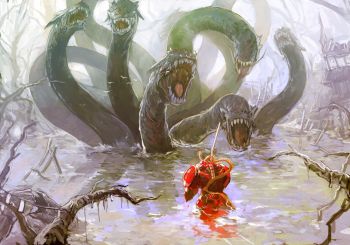Difference between revisions of "Hydra"
Tao alexis (talk | contribs) |
Tao alexis (talk | contribs) |
||
| Line 38: | Line 38: | ||
'''Hydrae''' are large, serpentine beasts often dwelling in partially or wholly submerged subterranean or ruinous lairs. They were the offspring of [[Typhon]] and [[Echidna]] and there are well over a hundred of them scattered from the Mediterranean throughout the Middle East and as far away as southern India. The creature has a large, fat body; the rear is about 10 ft. wide and 14 ft. long, ending in a stumpish tail. The body's front is supported on two immense stalk-like legs, similar to a brontosaur. From the forepart of this muscled, leathery mass emerges a forest of snake-like tentacles with ridged or knobbed heads, vaguely remiscent of dragons, with which the beast is purportedly related. | '''Hydrae''' are large, serpentine beasts often dwelling in partially or wholly submerged subterranean or ruinous lairs. They were the offspring of [[Typhon]] and [[Echidna]] and there are well over a hundred of them scattered from the Mediterranean throughout the Middle East and as far away as southern India. The creature has a large, fat body; the rear is about 10 ft. wide and 14 ft. long, ending in a stumpish tail. The body's front is supported on two immense stalk-like legs, similar to a brontosaur. From the forepart of this muscled, leathery mass emerges a forest of snake-like tentacles with ridged or knobbed heads, vaguely remiscent of dragons, with which the beast is purportedly related. | ||
| − | [[File:Hydra.jpg|left| | + | [[File:Hydra.jpg|left|350px]] |
The body moves slowly, but the heads are quick, with a [[Combat Hex|three-hex]] reach (15 ft.). The beast can attack in all directions at once. To protect themselves, they prefer to face enemies in water deep enough so that they can submerge, if attacked at a distance, and which hampers enemies who must wade in to fight them hand-to-hand. | The body moves slowly, but the heads are quick, with a [[Combat Hex|three-hex]] reach (15 ft.). The beast can attack in all directions at once. To protect themselves, they prefer to face enemies in water deep enough so that they can submerge, if attacked at a distance, and which hampers enemies who must wade in to fight them hand-to-hand. | ||
Revision as of 23:00, 3 September 2020
| Type | Hydra | Fire-breathing Hydra |
Lernean Hydra |
| Species | beast | ||
| No. Appearing | 1 | 1 | 1 |
| Behaviour | solitary | ||
| Range | jungle, subterranean |
ruin | |
| Size | 10 ft. tall | 10 ft. tall | 10 ft. tall |
| Weight | 600-1,400 lbs. | 720-960 lbs. | 1080 lbs. |
| Intelligence | 4 | 4 | 4 |
| Armour Class | 5 | 5 | 5 |
| Hit Dice | 5-12 | 6-8 | 9 |
| Action Points | 3 pts. for body; 1 pt. per head | ||
| Max. Stride | 2 | 2 | 2 |
| THAC0 | 18-14 | 17-16 | 15 |
| Hp/Die | d10, d4+d6 or d12 |
d10 or d4+d6 | d4+d6 |
| Attack Form | 5-12 bites | 6-8 bites | 9 bites |
| Damage | 2-12 | 2-12 | 2-12 |
| Special Attack | venom | breath weapon, venom |
immortal head, regeneration venom |
Hydrae are large, serpentine beasts often dwelling in partially or wholly submerged subterranean or ruinous lairs. They were the offspring of Typhon and Echidna and there are well over a hundred of them scattered from the Mediterranean throughout the Middle East and as far away as southern India. The creature has a large, fat body; the rear is about 10 ft. wide and 14 ft. long, ending in a stumpish tail. The body's front is supported on two immense stalk-like legs, similar to a brontosaur. From the forepart of this muscled, leathery mass emerges a forest of snake-like tentacles with ridged or knobbed heads, vaguely remiscent of dragons, with which the beast is purportedly related.
The body moves slowly, but the heads are quick, with a three-hex reach (15 ft.). The beast can attack in all directions at once. To protect themselves, they prefer to face enemies in water deep enough so that they can submerge, if attacked at a distance, and which hampers enemies who must wade in to fight them hand-to-hand.
WORKING...
See Bestiary
